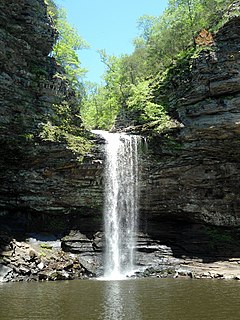
Petit Jean State Park is a 3,471-acre (1,405 ha) park in Conway County, Arkansas managed by the Arkansas Department of Parks and Tourism. It is located atop Petit Jean Mountain adjacent to the Arkansas River in the area between the Ouachita Mountains and Ozark Plateaus.

U.S. Highway 63 is a north-south U.S. highway that begins in Ruston, LA. In the US state of Arkansas the highway enters the state from Louisiana concurrent with US 167 in Junction City. The highway runs north through the eastern part of the state, serving rural areas of South Arkansas and the Arkansas Delta, as well as Pine Bluff and Jonesboro. The highway exits the state at Mammoth Spring traveling into Missouri.
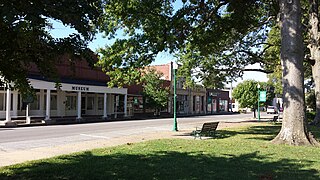
The Hale Avenue Historic District encompasses a significant portion of the central business district of Osceola, Arkansas. It extends for five blocks along Hale Avenue, between Ash and Maple Streets, and includes a few buildings on adjacent streets. The focal point of the district is the Mississippi County Courthouse, and the block of buildings opposite it on Hale Avenue. Although Osceola was founded in 1875, it was relocated beginning in 1900 to be closer to the railroad, with Hale Avenue as the major east–west route. This began a period of growth in the city which continued through much of the 1920s. Most of buildings on these blocks of Hale Avenue result from this time, and a number of those built later were built in an architecturally sympathetic manner.

The Masonic Temple of El Dorado, Arkansas is located at 106-108 North Washington Street, on the west side of the courthouse square. The four-story masonry building was built in 1923–24 to a design by Little Rock architect Charles S. Watts. It is one of a small number of buildings in Arkansas with Art Deco styling influenced by the Egyptian Revival. This particular styling was likely influence by the 1922 discovery of the Tomb of Tutankhamun.
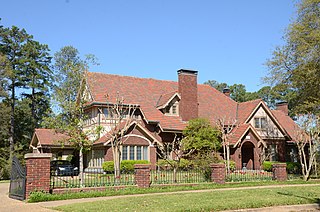
The Charles H. Murphy Sr. House in El Dorado, Arkansas, was built in 1925. The 2+1⁄2-story house was designed in Tudor Revival style by architect Charles L. Thompson, and built in 1925–26, during El Dorado's oil boom years. Charles Murphy was a major landowner, originally in the lumber business, who benefitted greatly from the oil boom due to the increased value of local real estate. He founded the predecessor company to Murphy Oil, which is still headquartered in El Dorado.
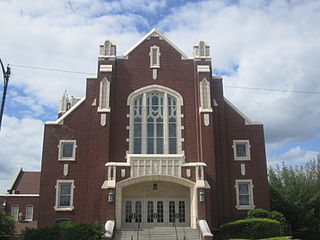
The First Presbyterian Church is a historic church at 300 E. Main in El Dorado, Arkansas. The single story brick building was constructed in 1926 for a congregation which was organized in 1846. The Collegiate Gothic building was built during El Dorado's 1920s boom occasioned by the discovery of oil, and its ensuing rapid growth. It was designed by the architectural firm R. H. Hunt and Associates.

The Bank of Commerce building is a historic commercial building at 200 North Washington Street in El Dorado, Arkansas. The Classical Revival two story brick building was constructed in 1919–20, and is one of the few buildings in El Dorado's downtown that retains its historical facade from that period. The building was renovated in the 1940s and 1950s, actions that gutted its interior, but only covered over the main facade with a new layer of brick, and left the secondary southern facade intact. In the early 1980s the building's exterior was restored to its 1920s appearance.
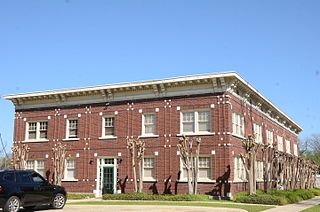
The El Dorado Apartments in El Dorado, Arkansas are a historic apartment house at 420 Wilson Place. The two story brick and limestone building was designed by Louisiana architect Cheshire Peyton, and built in 1926 in response to the discovery of oil in the area and the ensuing economic boom. It houses 24 small efficiency units, designed for use by the transient but wealthier workers and managers of the oil-related economy. The building has limestone window sills, and rows of brick-inlaid limestone squares between the windows. The cornice of the flat roof is decorated with brick dentil moulding and modillions.

The El Dorado Confederate Monument is located on the grounds of the Union County Courthouse in El Dorado, Arkansas, near the corner of North Main and South Washington Streets. It consists of a statue of a Confederate Army soldier in mid-stride, mounted on top of a temple-like structure supported by four cannon-shaped Ionic columns. The columns support a lintel structure bearing inscriptions on three sides, above which is a tiered roof with cannonballs at the corners. The temple structure is 15 feet (4.6 m) high, and 10 feet (3.0 m) square; the statue measures 76 inches (1.9 m) by 28 inches (0.71 m) by 28 inches (0.71 m). Both the statue and the temple are constructed of gray/blue striated marble.

The El Dorado Junior College Building is a historic academic building at 300 South West Avenue in El Dorado, Arkansas. The three story brick building was built in 1905 as a public school building for the county's white students. From 1925 to 1937 the building house El Dorado Junior College, the first such institution in southwestern Arkansas; it has seen a variety of public and private academic uses since then. The building is shaped roughly like a swastika, and has retained most of its external and internal Classical Revival style.

The Exchange Bank building, formerly the Lion Oil Headquarters, is a historic commercial building at Washington and Oak Streets in El Dorado, Arkansas. Built in 1926–27, the nine story building was the first skyscraper in Union County, and it was the tallest building in El Dorado at the time of its listing on the National Register of Historic Places in 1986. It was designed by the Little Rock firm of Mann & Stern, and is an eclectic mix of Venetian-inspired Revival styles. It was built during El Dorado's oil boom, and housed the headquarters of Lion Oil. It was included in the El Dorado Commercial Historic District in 2003.

The El Dorado Commercial Historic District encompasses the historic commercial heart of downtown El Dorado, Arkansas. The city serves as the seat of Union County, and experienced a significant boom in growth during the 1920s, after oil was discovered in the area. The business district that grew in this time is anchored by the Union County Courthouse, at the corner of Main and Washington Streets, where the Confederate memorial is also located. The historic district listed on the National Register of Historic Places in 2003 includes the city blocks surrounding the courthouse, as well as several blocks extending east along Main Street and south along Washington Street. Most of the commercial buildings are one and two stories in height and are built of brick. Notable exceptions include the Exchange Bank building, which was, at nine stories, the county's first skyscraper, and the eight-story Murphy Oil building. There are more than forty contributing properties in the district.

The Mahony Historic District encompasses a residential part of El Dorado, Arkansas north of its downtown area. It was an area of significant development in the years after the 1921 discovery of oil and the ensuing economic boom. The area is bounded on the south by Champagnolle Road, on the west by a line just east of North Madison Avenue, on the north by East 5th Street, and on the east by North Lee Avenue and railroad tracks. It is just over 14 acres (5.7 ha) in size, and includes 94 buildings that contribute to its significance. The streets in the district are laid out in grid form, accounting for the fact that Champagnolle Road runs diagonally from southwest to northeast. Most of the housing in the district consists of modest single-story houses, with simple styling. This is a contrast to the adjacent Murphy-Hill Historic District, a more affluent area with a longer history of development. Only five houses in the district were built before 1920, and all lie on Champagnolle Road; most of the rest were built in the decade after the oil discovery. There is one church in the district, St. Mary's Episcopal Church, completed in 1950. The district was listed on the National Register of Historic Places in 2011.

The Henry Crawford McKinney House is a historic house at 510 East Faulkner Street in El Dorado, Arkansas. The 2+1⁄2-story red brick and stucco house was designed by Charles L. Thompson and built in 1925; it is one of the most elegant houses in the city, and is set on an elaborately landscaped parcel. The house was built for Henry Crawford McKinney, Sr., a prominent local landowner and banker, during the height of El Dorado's oil boom. Its interior decoration was done by Paul Heerwagen, best known for his murals in the Arkansas State Capitol.

The W.F. & Estelle McWilliams House is a historic house at 314 Summit Avenue in El Dorado, Arkansas. The two story brick house was built in 1922 for William and Estelle McWilliams, early in El Dorado's oil boom, which was prompted by the discovery of oil in 1921. McWilliams was a prominent local businessman who operated a number of retail businesses, was a local bank director, and built the Rialto Theatre. The McWilliams house is a stylistically eclectic combination of Craftsman, Classical Revival, and Mission/Mediterranean styling. Based on stylistic evidence, it may have been designed by the Little Rock firm of Kolben, Hunter and Boyd.
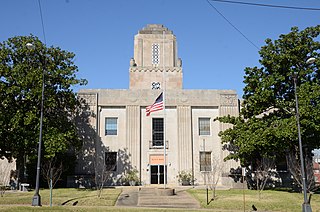
The Municipal Building, or City Hall, of El Dorado, Arkansas is located at 204 North West Street.

The Rialto Theatre is a historic performing venue at 117 East Cedar Street in downtown El Dorado, Arkansas. Built in 1929 during El Dorado's oil boom years, the theater is one of the best local examples of Classical Revival architecture, and is one of the largest and most elaborately decorated performing spaces in southern Arkansas. It was designed by the local firm of Kolben, Hunter and Boyd, and seats 1400. Its main entrance has Egyptian Revival details, and is flanked by storefronts. The brick of the front facade is laid in a basketweave pattern, and is topped by a stone frieze, cornice, and parapet. The interior of the theater is elaborately decorated. The theater was owned for many years by the McWilliams family. It was closed from 1980 to 1987 and then reopened as a three-screen movie theater that operated until 2006. The main lobby and concessions area operated briefly as a bar called Marilyn’s. In 2012, it was purchased by the Murphy Arts District, who announced plans to restore it in phase two of its plans for revitalizing downtown El Dorado. The theater, which will have floor seating for 850 in addition to a full balcony, will host a variety of musical acts, plays, comedy shows, and movies.

The Newton House Museum, also known as the Matthew Rainey House, is a historic house museum at 510 North Jackson Street in El Dorado, Arkansas, United States. The house was built sometime between 1843 and 1853 by Matthew Rainey, El Dorado's first settler, and is the oldest building in the city. It is a vernacular two-story wood-frame structure with a central hall and rooms on either side. It stands at the edge of a 4-acre (1.6 ha) parcel, having been moved from its center in 1910.

The Murphy–Hill Historic District encompasses the oldest residential portion of the city of El Dorado, Arkansas. It is located just north of the central business district, bounded on the north by East 5th Street, on the west by North Jefferson and North Jackson Avenues, on the east by North Madison Avenue, and on the south by East Peach and East Oak Streets. Six of the 76 houses in the 40-acre (16 ha) district were built before 1900, including the John Newton House, one of the first buildings to be built in El Dorado. Of particular note from this early period is a highly elaborate Queen Anne Victorian at 326 Church Street.




















